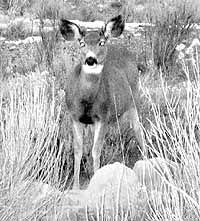| Chronic wasting disease continues to be a concern for Utah wildlife officials after a second deer has tested positive for the illness. The disease is common among deer and elk herds and leads to death for each mammal that comes in contact with the illness. |
The Division of Wildlife Resources announced late last week that an adult female deer from southeastern Utah has tested positive for chronic wasting disease.
“The deer had been acting sick, so when it died, its carcass was submitted for testing according to our wasting disease surveillance protocol,” stated DWR wildlife section chief, Alan Clark.
The deer died on April 22 in an agricultural field on the west side of the LaSal Mountains in southeastern Utah, about 10 miles from Moab.
Wildlife personnel collected the deer and sent it to the Utah State University Provo veterinary diagnostic laboratory for a necropsy.
Ultimately the animal was determined to be positive for the disease, which was the official cause of death.
This is the second deer in Utah to test positive for the disease. A deer harvested by a hunter last fall on Diamond Mountain north of Vernal also tested positive for the disease which results in death for this mammal.
“It’s important to remember that there is currently no evidence that chronic wasting disease can be naturally transmitted to humans or livestock,” advised DWR big game coordinator, Jim Karpowitz. “It also does not appear to cause catastrophic die offs in deer or elk populations.”
A great deal of research is being conducted by many agencies and organizations to learn more about this relatively new disease.
“Until more is known, we’ll continue to be diligent with our surveillance and management efforts and provide the public with the most current information available,” Karpowitz stated.
Because there is considerable concern that chronic wasting disease will spread into additional Utah deer and elk populations, the Utah wildlife division will conduct random samplings of harvested deer and elk to check for the disease, especially in the eastern Utah area.
The wildlife division describes the disease as a relatively rare transmissible disease that affects the nervous systems of afflicted deer and elk.
Infected animals develop brain lesions, become emaciated, appear listless and droopy, may salivate excessively and eventually die.
The wildlife division explains that there is no evidence that the disease naturally infects other big game species or domestic livestock.
Utah residents who participate in big game hunting should be aware of the recommended precautions the wildlife division has set up to ensure that the disease does not spread.
The following tips are not only for the safety of wildlife, but also the safety of Utah hunters.
•Animals that appear sick should not be harvested. The meat from suspected ill animals should not be consumed by humans.
•Wear rubber or latex gloves when field dressing big game.
•Bone out the meat or at least avoid consuming the brain, spinal cord, eyes, spleen and lymph nodes of harvested animals.
•Minimize handling of the soft tissues and fluids.
•Wash hands with soap and warm water after handling any parts of the carcass.
•Contact the DWR for additional information if a sick animal is spotted.
Carbon County residents can learn more about the disease by logging onto the DWR’s Internet website at www.wildlife.utah.gov/hunting/biggame/cwd.
Another excellent source of information is a national website ran by the chronic wasting disease alliance at www.cwd-info.org.
“This site includes links to chronic wasting disease information on other web sites as well,” Karpowitz explained. “I would encourage Utah residents to link from it to Wisconsin’s site, which has some excellent information about the disease.”

